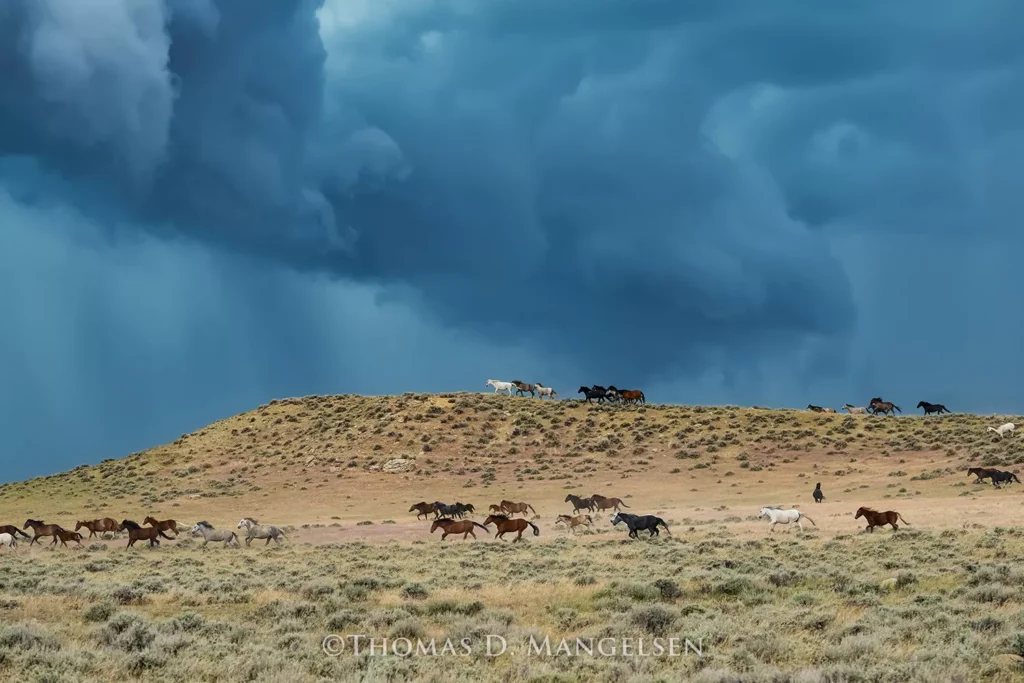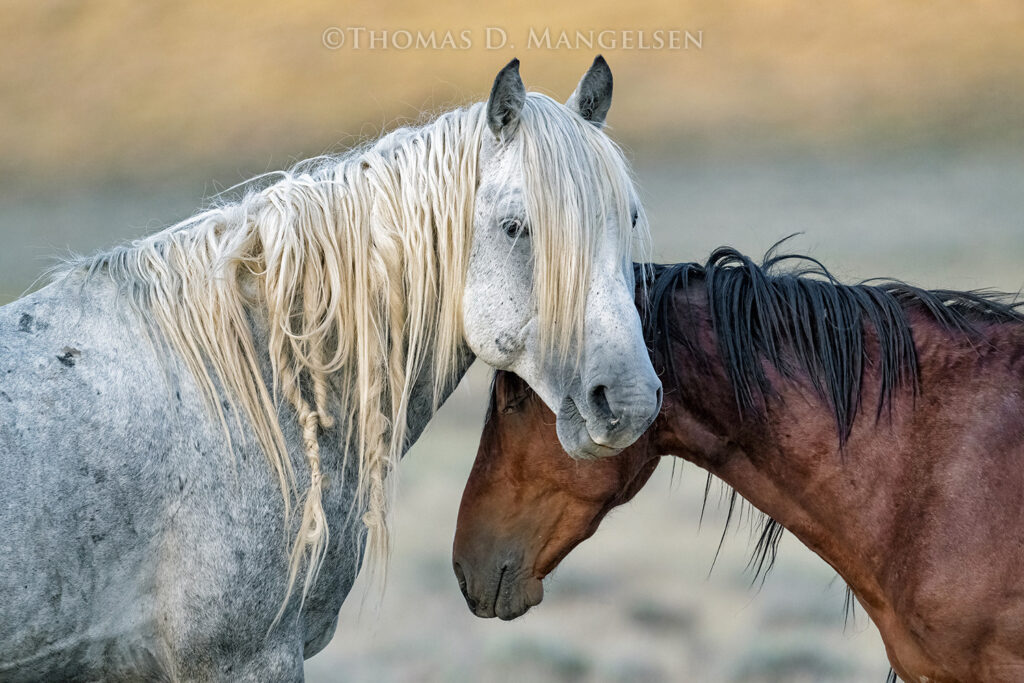A Call to Conserve: Keeping Public Lands Wild and Ensuring Humane Treatment for All Creatures

By Thomas D. Mangelsen
Imagine a classic Western movie or TV show—one that falls under the genre of “cowboys and Indians”—but with no horses in the scenes. Imagine “ranching culture” without equines. Imagine how different the navigation of the West would have been without horses. Imagine how different life would be for the two million Americans involved with raising and riding their beloved horses.
Now, let me take you into the heart of a controversy that isn’t going to end anytime soon. It involves three topics near and dear to my heart: the importance of public lands, keeping them ecologically healthy, and the humane treatment of other non-human sentient beings.
While some folks argue whether the horses roaming free across the open rangelands of the West are “wild,” “feral,” or “invasive,” what can’t be argued is their power as cultural icons. To stretch the “imagine” idea a little further—what would Wyoming be without its Cowboy State branding, or the Cheyenne Stampede—“the Daddy of ’em All”—if there were no horses in the arena?
How can a state with horses so deeply engrained in its identity now turn a blind eye to this travesty? Is the love for a totem animal only situational—only when it’s convenient?
Wild horses exist in at least ten Western states and a few places back East. They’re protected by federal law under the Wild Free-Roaming Horses and Burros Act of 1971.
In recent years, I’ve become increasingly outspoken against the efforts to round up and send thousands of these animals to slaughter or shove them into holding areas for the rest of their lives—not just in my home state of Wyoming, but across the West. Right now, the Bureau of Land Management—pushed by livestock industry pressure—is planning to remove more than 5,000 horses and completely zero out horse populations in several BLM zones in southwest Wyoming starting in July. We need to act now.
What’s going on here is part of a broader federal campaign to drastically cut wild horse numbers across the West. The reasons they give are usually the same: the horses are overgrazing, harming wildlife, or causing trouble when they wander from public to private lands.
Sure, there’s some truth in all that. But what gets conveniently overlooked is this: horses are being scapegoated because they eat the same grass that ranchers want for their cows and sheep. That’s the heart of it.
For more than a hundred years, ranchers have had the privilege of grazing their private livestock on public land. And they’re not paying market rates to do it—those grazing fees are dirt cheap. That means the American public is subsidizing their profits. Meanwhile, scientific studies show its cattle and sheep—not wild horses—that are doing the real damage to native plants, water, and wildlife.
The dry, dusty West isn’t the best place to raise cattle anyway. There are far better places east of the Rockies. Yet here we are.
Now, I understand wanting to keep horses off private property. But this idea that horses can’t even be tolerated on nearby public land? That’s extreme—and it sets a dangerous precedent. It reminds me of what’s happening in Wyoming’s Upper Green River Valley, where ranchers have pressured the U.S. Fish and Wildlife Service to allow dozens of grizzlies to be killed on public land just to protect livestock. Public land should serve the public interest—not just private industry
And the argument that horses are “bad” because they’re not recently native? That’s rich.
Horses have almost no natural predators these days. Occasionally a coyote or mountain lion might take a foal, but even those predators are being shot, trapped, and poisoned by Wildlife Services—a division of the USDA. I’ve seen the bones—piles of desiccated carcasses: coyotes, cougars, jackrabbits, you name it—all killed to keep livestock safe. These days, the main predator of wild horses is us.
Yes, horse herds can grow by about 20% a year. But according to a federal report, from 1971 to 2001 the BLM removed nearly 193,000 horses and burros from public lands. By 2017, the total wild population had dropped to about 83,000. Meanwhile, millions of acres that could support wild horses are being used by millions of non-native cattle and sheep—again, with taxpayers footing the bill.
On land that belongs to all of us—hundreds of millions of acres—cattle and sheep production has led to the poisoning and removal of native predators, the spread of noxious weeds, muddy and degraded streams, and a whole mess of other ecological problems.
Cattle and sheep have long been treated like sacred cows. Horses? They’ve become the scapegoats and sacrificial lambs.
The truth is, species of horses once existed in the West but went extinct around 8,000 to 11,000 years ago, probably because of changing climate and early hunters. They came back to North America with the Spanish and other European colonizers over 500 years ago. Some escaped and became free-ranging. Over time, they adapted and arguably became wild again—forming herds, raising foals, and fitting back into the ecosystem they once ruled.
Native tribes quickly recognized their value. Horses helped shape Plains culture—used for hunting bison, traveling great distances, and defending territory.
Sure, wild horses have an impact on the land. No one’s denying that. But compared to what? Are we seriously saying the solution is to wipe out entire herds? That’s not sound management—it’s a blunt instrument. And it raises real questions about who gets to decide what belongs on our shared lands.
Groups like Wild Horse Education, the American Wild Horse Campaign, Western Watersheds Project, the Animal Welfare Institute, and some brave individuals have taken these issues to court—and won.
I have personally witnessed BLM “gathers” firsthand. They’re brutal. I watched helicopters chase terrified horses across open terrain in the heat of summer. Foals collapsed. Mares were separated from their young. Families shattered. It was one of the most heartbreaking, unjust things I’ve ever seen done to animals in this country.
If we rounded up cattle and sheep this way, people would call it cruelty. And they’d be right.
We’re talking about wild, sentient animals—families and herds with bonds and memory—being stolen from the only home they’ve ever known.
We need a better plan. The BLM’s current approach is outdated, reactionary, and tone-deaf to the complex ecology and culture of the West. It reminds me of Montana’s effort to kill off bison that wander beyond Yellowstone’s boundary.
Wyoming and others have tried to argue that horses harm Greater Sage-Grouse habitat—but they ignore the much bigger threats: overgrazing, oil and gas drilling, and housing sprawl.
If federal agencies really care about restoring rangelands, let’s talk about all the grazers—not just the wild ones.
Let’s stop pretending that 80,000 horses are the problem when millions of cattle and sheep graze hundreds of millions of acres. There shouldn’t be any sacred cows—or scapegoats.
If the goal is having an honest gauging of impacts, then let’s cowboy up and get real.
We can no longer tolerate sentient animals—families, herds, and bands—forever separated and ripped from the wild, knowing nothing about captivity, to be stolen from the wild where their ancestors, bison, and Native Americans once roamed across the West. The wild horse is the last remnant of those bygone days, and we cannot let it slip away now.
We must not let them disappear. Not now. Not on our watch.
Protect America’s Wild Horses – Take Action Now!
Raise Your Voice – Be Their Advocate
America’s wild horses are at risk. The Bureau of Land Management (BLM), driven by livestock industry pressure, plans to remove over 5,000 wild horses and completely zero out populations in several BLM zones in southwest Wyoming starting this July. We need to act now.
What You Can Do:
- Call Your Local Representatives
Let your local representatives know that you oppose the cruel helicopter roundups and long-term confinement of wild horses. Demand their rightful federal protections. - Call the US Capitol switchboard at 202-224-3121.
Clearly state your opposition to the removal and confinement of wild horses. Request a follow-up email to confirm your message has been documented. Demand proof that your message has been “seen” and acknowledged—not just heard.
Remember: One phone call can be ignored, but thousands cannot. Be persistent. Call often. Demand action.
They Need Us Now
With the survival of America’s wild horses at stake, your voice can make a difference. Speak up before it’s too late.

